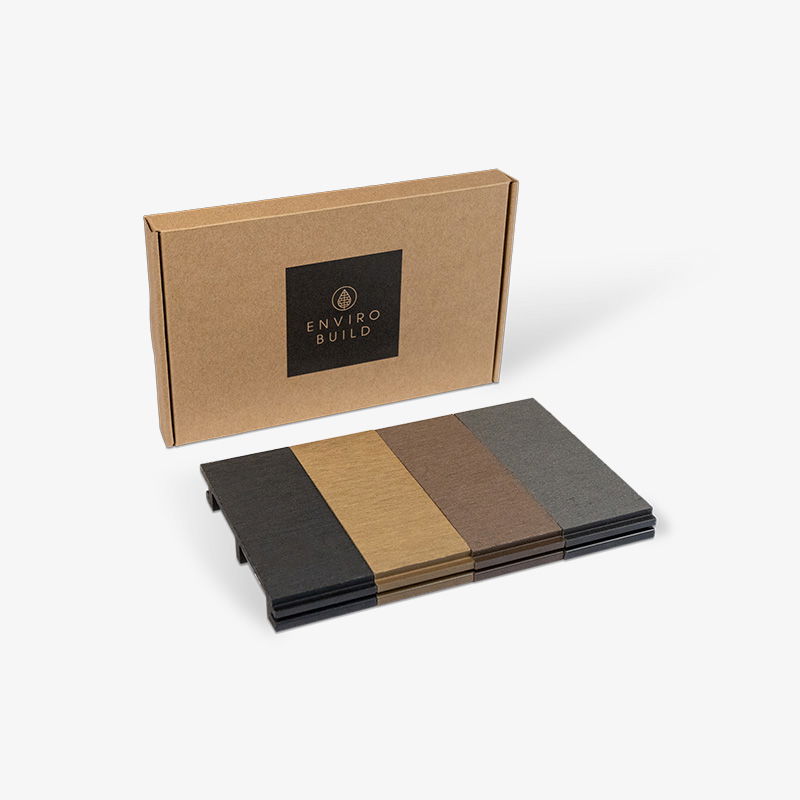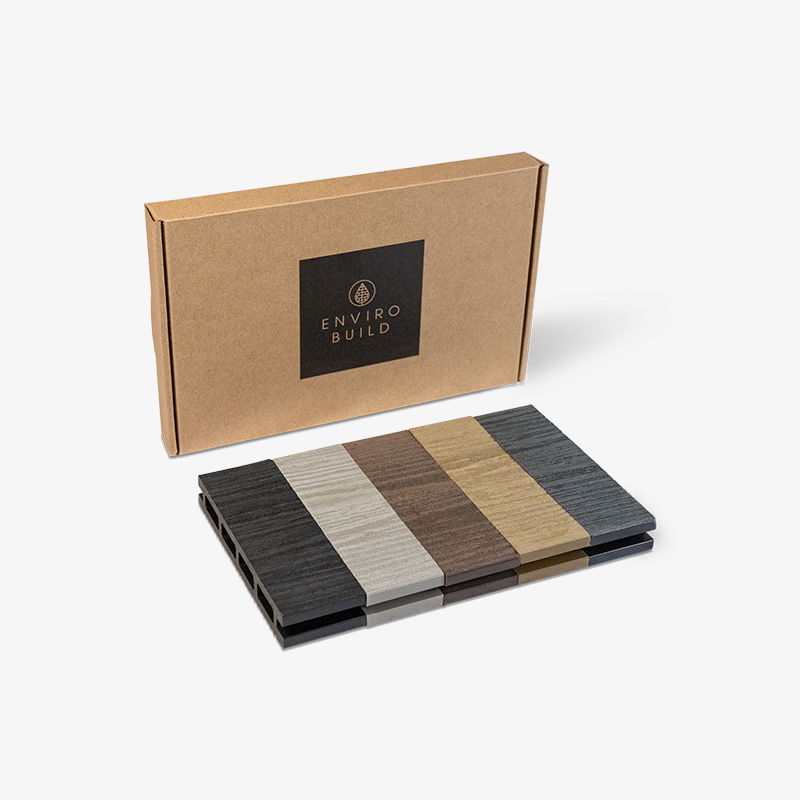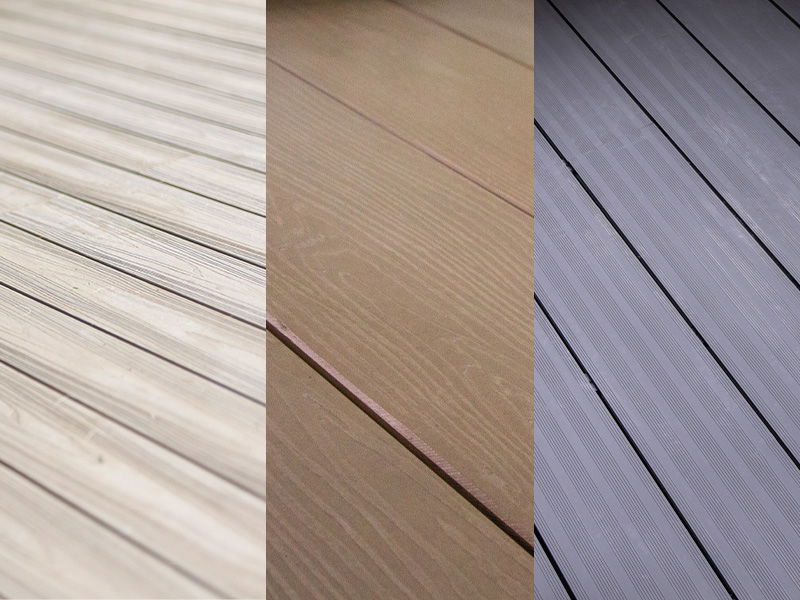100% Recycled Plastic Decking
Made entirely from post-consumer waste, 100% recycled plastic decking offers a zero-maintenance, long-lasting alternative to timber and composite boards. Designed to resist rot, splintering and water damage, it’s the ideal choice for high-wear outdoor spaces where durability matters most.
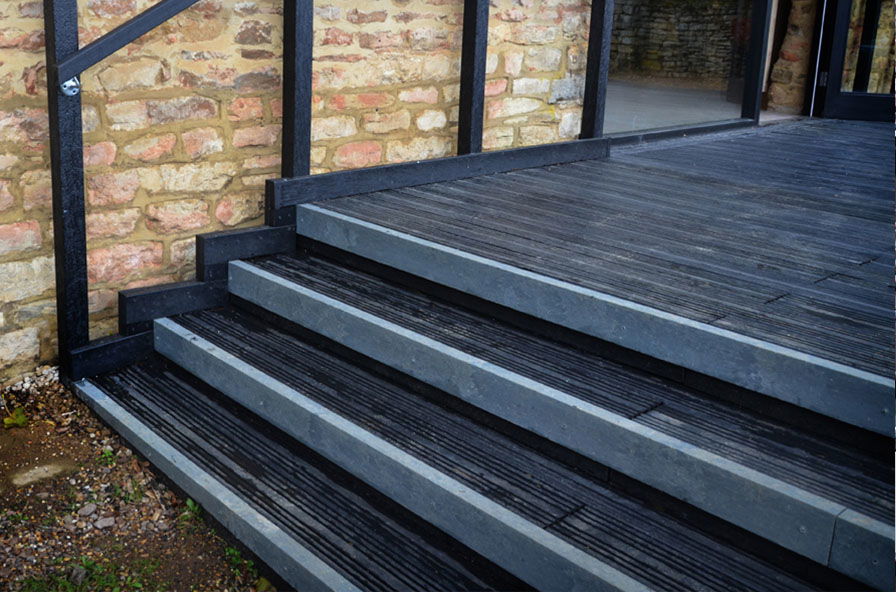
Looking For Composite Decking?
Composite decking combines recycled wood and plastic to deliver the appearance of timber with lower maintenance, perfect for garden decks, patios and outdoor living spaces.
Call to Action

Section Heading
Fast Delivery
Orders over £1200 are delivered free of charge
Trusted Warranty
Peace of mind with long-lasting protection
Trade Discounts
Exclusive discounts for installers and contractors
10% Pledge
We donate 10% of profits to sustainable causes
Decking Substructure & Accessories
To ensure long-term performance, recycled plastic decking should be installed over a durable, rot-proof substructure. We recommend using recycled plastic lumber joists and adjustable pedestal systems to create a stable, low-maintenance base that won’t degrade over time.

Decking Joists
Joists form the essential framework beneath composite decking, providing long-term structural stability and support.
View Joists
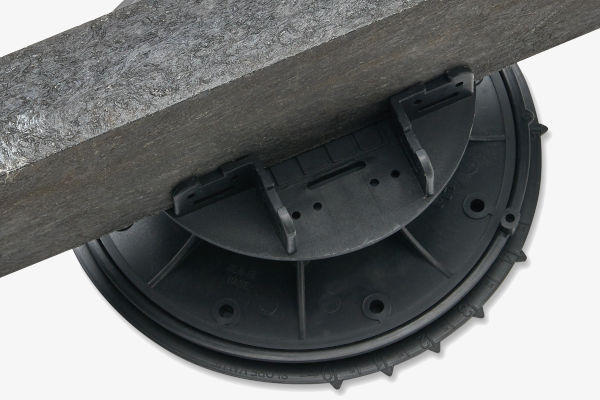
Adjustable Pedestals
Pedestals support decking joists and are easily adjustable to provide perfect levelling, even on uneven ground or sloping surfaces.
View Pedestals

Heading
Card description goes here.
Call to Action
100% Recycled Plastic Decking Installation
Recycled plastic decking is designed for straightforward installation with standard tools and fixings.
Secure surface fixing with standard screws
Plastic decking boards are fixed directly into plastic joists using corrosion-resistant screws, making installation fast and reliable.
Install over non-rot substructure
Plastic joists are ideal for damp or ground-level installs and ensure your decking remains stable and low-maintenance for decades.
Step-by-step installation guide
We offer a guide that walks you through the process, from preparing the substructure to fixing boards.
Support for builders with trade pricing
We value our trade partners and understand the importance of reliable pricing, product availability, and expert support
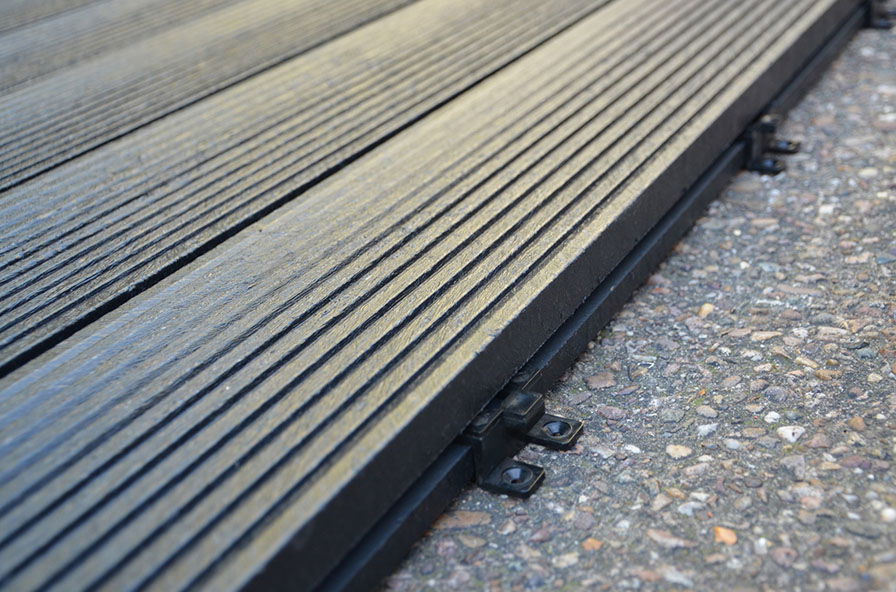
Recycled Plastic Decking FAQs
If you don’t find the answer you're looking for, our team of experts is here to help. Give us a call on 020 8088 4888
No, composite decking will not rot, one of its biggest advantages over traditional timber. Composite decking boards are made from a blend of recycled wood fibres and high-performance plastics, creating a dense, moisture-resistant material that resists the fungal growth and decay associated with natural wood.
Unlike timber, which can absorb water and break down over time, eco-friendly outdoor decking made from composite materials is specifically engineered to be low-maintenance and long-lasting—even in wet or humid environments.
Moisture resistance: The plastic content repels water, preventing it from seeping into the board.
No organic breakdown: With no exposed wood grain, there’s no food source for fungi or mould that cause rot.
Capped protection (on some ranges): Premium capped boards have an added polymer shell for even greater protection against moisture, staining, and mildew.
If you're looking for a decking solution that resists the elements and avoids the pitfalls of rotting wood, composite decking boards are a reliable and sustainable choice for both residential and commercial projects.
Composite decking is designed for long-term colour stability, but some initial fading or lightening is normal, especially in uncapped boards. This early change is due to UV exposure and the natural bleeding of tannins from the wood fibres within the board.
Tannin leaching: During the first 8 - 10 weeks after installation, especially in wet weather, tannins from the wood content may leach out of uncapped boards. This can temporarily darken or stain the surface but is a normal part of the weathering process and usually washes away naturally.
UV exposure: Like any outdoor material, sunlight can cause surface fading. With composite decking, this typically results in a slight lightening that stabilises quickly.
Uncapped composite decking: May show more visible tannin marks and minor colour change initially, but these boards settle into a consistent tone over time.
Capped composite decking: Features a durable polymer shell that resists both UV damage and tannin staining, offering superior fade resistance and longer-lasting colour.
Once early weathering is complete, composite decking boards settle into a consistent tone and require no painting or staining. It’s a simple, low-maintenance way to create a great-looking outdoor space that stays that way.
No, composite decking is designed to offer excellent slip resistance, even in wet conditions. While no outdoor surface can be entirely slip-proof, especially in areas prone to standing water or algae, most composite decking boards outperform traditional timber due to their engineered textures and low-porosity surfaces.
Textured surface finishes: Composite boards are manufactured with slip-resistant patterns, such as grooves or embossed woodgrain, that provide reliable grip underfoot.
Low water absorption: Unlike timber, composite decking boards do not swell or become slippery as they absorb water. Their material composition resists moisture ingress, reducing long-term hazards.
Correct deck installation is essential. A slight fall or slope allows water runoff, preventing puddling that can lead to slippery areas.
Routine cleaning helps maintain optimal performance. Keeping the surface free from organic debris, algae, and mould is key to long-term slip resistance.
When properly installed and maintained, composite decking provides a safe and reliable solution for outdoor spaces.
Technically, yes, you can paint composite decking, but it’s generally not recommended. Most composite decking boards, particularly capped varieties, are engineered with a protective outer shell that resists moisture, fading, and staining. This makes paint unlikely to adhere properly and can void the manufacturer’s warranty.
Low-Maintenance by design: One of the key benefits of composite decking is that it never needs sanding, sealing, or painting, making it a true low-maintenance decking solution.
Warranty risks: Altering the board’s surface may compromise product guarantees, especially for UV and stain resistance.
For older, uncapped composite boards that have faded significantly or suffered surface damage, painting may be a last-resort option.
Ultimately, for a long-lasting and eco-friendly outdoor decking solution, it’s best to choose a composite board in a colour you’re happy with long-term, avoiding the need to paint altogether. Proper deck installation and minimal upkeep will ensure a consistent, durable finish for years to come.
Maintaining composite decking is straightforward and significantly easier than with traditional timber. Designed as a low-maintenance decking solution, composite boards require only occasional cleaning to keep them looking their best and performing well year-round.
Regular cleaning: Sweep the deck regularly to remove leaves, dirt, and debris. This prevents staining and helps avoid mould or algae build-up.
Washing: Clean the surface with warm soapy water and a soft-bristle brush, or use a pressure washer on a low setting (typically under 1500 psi). Always follow the grain of the board to avoid damage.
Tannin & water marks: Some early weathering, such as tannin leaching or water spots, is normal and will fade over time. Light rinsing or gentle scrubbing can help.
Avoid harsh chemicals: Do not use bleach, strong solvents, or oil-based cleaners, as they may damage the surface or compromise colour stability.
Ensure proper drainage during deck installation to reduce standing water and prevent slipping or staining.
Inspect fixings and joists annually to ensure the substructure remains secure, particularly on commercial or high-traffic installations.
Thanks to its durability and weather resistance, eco-friendly outdoor decking made from composite materials delivers long-lasting performance with minimal effort, making it ideal for both residential gardens and large-scale landscaping projects.
Composite decking is a man-made building product manufactured with a blend of wood fibres, plastic polymers and a small amount of bonding agents. This mix is heated, formed into board shaped lengths and then cooled.
Recycled wood fibres: Typically sourced from sawdust or reclaimed wood, these fibres provide the deck board with strength and a natural grain-like texture.
Recycled plastics: High-density polyethylene (HDPE) or polypropylene is used to bind the board together and add moisture resistance. These plastics are often sourced from post-consumer waste such as packaging or plastic bottles.
Additives and binders: Colour pigments, UV inhibitors, and bonding agents are added to improve fade resistance, colour consistency, and structural stability.
Capped composite decking includes a protective polymer shell that surrounds the core, providing enhanced resistance to staining, fading, and moisture.
Uncapped composite decking boards are more affordable but may be more susceptible to early weathering or surface marking.
This eco-friendly outdoor decking solution not only diverts waste from landfill but also offers excellent durability and aesthetics with minimal upkeep.
In many ways, composite decking is a better long-term choice than traditional wood decking, especially when it comes to durability, maintenance, and environmental impact. While timber remains popular for its natural aesthetic and lower upfront cost, composite decking boards offer several key advantages that make them a smarter investment for modern outdoor spaces.
Low maintenance: Composite decking doesn’t require sanding, staining, or sealing. Occasional cleaning is all that’s needed, making it a truly low-maintenance decking solution.
Longer lifespan: Unlike timber, composite boards won’t rot, splinter, warp, or suffer from insect damage.
Slip and fade resistance: Capped composite boards are designed to resist UV fading, stains, and moisture, maintaining their appearance.
Eco-friendly materials: Most eco-friendly outdoor decking options use recycled wood and plastics, reducing landfill waste and deforestation.
For some projects, such as heritage restorations or where a weathered natural finish is specifically desired, wood may be appropriate. However, for the vast majority of deck installation projects, especially where longevity, performance, and sustainability are priorities, composite decking is the superior choice.
The best composite decking depends on your specific style and needs: budget, location, intended use, and aesthetic. However, in general, capped composite decking boards are considered the highest-performing option on the market today due to their enhanced durability, stain resistance, and long-term colour retention.
Capped boards: These include a protective polymer shell that surrounds the core, offering superior resistance to fading, moisture, mould, and staining. Ideal for high-traffic areas or exposed outdoor spaces.
High slip resistance: Look for boards with textured surfaces or anti-slip certifications, particularly important for commercial spaces or wet climates.
Warranty coverage: Leading manufacturers offer warranties of 15–25 years or more, covering structural performance and colour stability.
Sustainable manufacturing: The best eco-friendly outdoor decking options are made from up to 90% recycled materials and manufactured using renewable energy.
The best composite decking balances performance, aesthetics, and sustainability. Whether you’re building a family-friendly outdoor retreat or specifying materials for a commercial project, investing in a high-quality, low-maintenance decking system ensures lasting value and professional-grade results.
Composite decking typically lasts 25 to 30 years or more, depending on the quality of the board, exposure to the elements, and how well it’s maintained. This far exceeds the lifespan of traditional timber decking, which often requires replacement after 10–15 years due to rot, warping, or insect damage.
Durable materials: Made from a blend of recycled wood fibres and plastic, composite decking boards resist moisture, mould, and decay.
Capped protection: Premium boards feature a protective shell that shields against fading, stains, and surface wear, significantly extending the deck’s usable life.
Low-maintenance performance: With no need for sanding, staining, or sealing, composite decking maintains its integrity with minimal upkeep, ideal for both homeowners and landscapers seeking reliable, long-term results.
With residential warranties ranging from 15 to 25 years (depending on product range), we have confidence in the long-term performance of our products.
Eco-friendly outdoor decking made from composite materials offers a low-maintenance decking solution that stands the test of time. While proper deck installation and basic care will ensure it continues to perform for decades.
The Benefits Of 100% Recycled Plastic Decking
Made from post-consumer plastic waste and engineered for extreme durability, recycled plastic decking is the ultimate choice for outdoor performance in wet conditions.
Will not rot, splinter or warp
Plastic decking doesn’t absorb moisture, so it won’t swell or split over time. It’s perfect for exposed areas or ground contact applications.
Completely maintenance-free
No staining. No sealing. No sanding. Once installed, recycled plastic decking requires virtually no upkeep.
Built to last decades
With an expected lifespan of 25+ years, plastic decking offers long-term value without compromise.
Support for builders with trade pricing
We value our trade partners and understand the importance of reliable pricing, product availability, and expert support
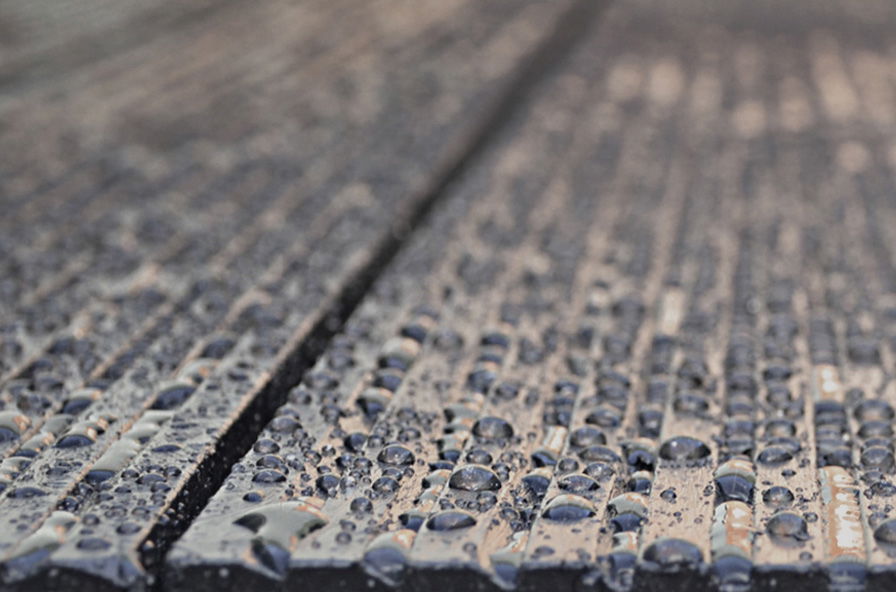
How To Care For Recycled Plastic Decking
One of the biggest advantages of 100% recycled plastic decking is how little care it needs. There’s no sanding, staining, or sealing required, just occasional cleaning to keep the surface looking its best.
Quick and easy cleaning
For regular cleaning, simply sweep the surface and rinse with water to remove dirt, leaves and debris.
No need for staining or sealing
Recycled plastic boards don’t require staining or protective coatings. The colour runs throughout the board and won’t fade or peel.
Built to resist algae and mould
Because plastic decking doesn’t absorb moisture, it’s far more resistant to mould, algae and decay.
Support for builders with trade pricing
We value our trade partners and understand the importance of reliable pricing, product availability, and expert support

Where To Use 100% Recycled Plastic Decking
Thanks to its rot-proof composition, slip resistance and zero-maintenance durability, 100% recycled plastic decking is ideal for a wide range of outdoor applications.
Ground-level decks
Ideal for domestic use where ground contact or damp conditions would cause timber to rot.
Coastal environments
Recycled plastic decking is completely waterproof and won’t degrade in salty air, making it perfect for marina walkways and seafront structures.
Public walkways and footpaths
With high slip resistance, it's a great choice for schools, parks, commercial footbridges and nature trails.
Support for builders with trade pricing
We value our trade partners and understand the importance of reliable pricing, product availability, and expert support

From the Blog
Popular articles from our blog with tips and ideas for getting the best from your project.
Order your free sample pack today
Not sure which composite decking is right for your garden project? Our free sample packs take the guesswork out of choosing. See the colours in natural light and feel the textures before making a decision - all from the comfort of your own home.
Delivered quickly and free of charge
Composite decking boards feature a hidden clip system that secures each board in place without visible screws on the surface.
Step-by-step installation guide
We provide a detailed installation guide to walk you through every stage of the process.
Find an installer with our installer network
Connect with our network of trusted and experienced composite decking installers across the UK
Support for builders with trade pricing
We value our trade partners and understand the importance of reliable pricing, product availability, and expert support


All wood materials we use are FSC® certified

Member of World Land Trust's Carbon Balanced Programme

We donate 10% of our profits to Rainforest Trust UK

